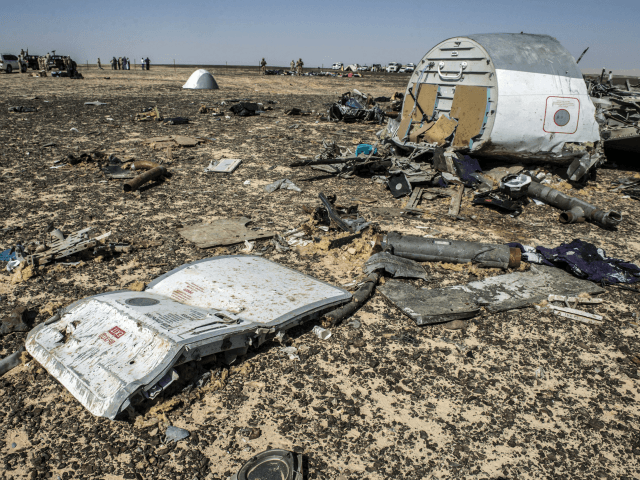Intelligence that first suggested an attack may have brought down a Russian passenger jet over Egypt last week (pictured above) largely justifies the mass surveillance carried out by US and British spies, experts said.
While accumulating massive amounts of intercepted telephone and electronic communications and satellite imagery can hardly ever prevent an attack, it can help to shed light afterwards on what happened, they said.
The Times and the Daily Telegraph reported Friday that the US National Security Agency (NSA) and Britain’s GCHQ had intercepted telephone calls recorded before the catastrophe.
They concluded from the intercepts that it was possible that an attack by the Egyptian branch of the Islamic State group, known as Sinai Province, had brought down the plane after it took off from Sharm el-Sheikh.
On Friday, a source close to the investigation said the black boxes recovered from the Saint Petersburg-bound jet point to a bomb attack, apparently confirming suspicions expressed by US President Barack Obama and British Prime Minister David Cameron.
“What the NSA is doing is effectively trawler fishing, trawling all the information,” a former head of the French intelligence services told AFP, speaking on condition of anonymity.
The technique is known as “bulk collection”.
“They take everything they can. The ideal thing is to be able to connect all that up and to put it together with other types of information to be able to prevent anything happening.
“(But) experience shows that preventing this kind of thing is very difficult, even impossible.”
“In saying (he suspected a bomb), Obama simply read out the note that the intelligence services had prepared for him,” he continued.
“They will say: ‘We got this or that, we compared it with this or that and everything leads us to believe that’… After that it is up to the politicians.”
– ‘Hide their traces’ –
Satellite images recording a flash when a plane crashes or explodes — like that reportedly picked up by the US military at the time of the Egypt crash — can also be crucial to an investigation, a former French foreign intelligence agency official said.
The picture can be fed into a super-computer used to compare thousands of pieces of information.
“It may not have been evident at the time, but after the event, information is collated and it makes sense,” he said.
However, the intelligence services’ claims should be approached with caution, according to Shashank Joshi, senior research fellow at the London-based Royal United Services Institute.
“In the last few years, since the Edward Snowden revelations, we have seen some pretty big claims from intelligence agencies like GCHQ and NSA,” he added referring to the former US intelligence whistle-blower.
Such claims, he said, included “all the things they have foiled and all the things they wouldn’t be able to do if they didn’t have ‘bulk powers’ or they didn’t have the ability to break encryption,” Joshi told AFP.
“In practice, a lot of those claims have turned out to be a lot more feeble when examined in more detail.
“That’s why I think we have to be very sceptical about assuming that dragnet analysis has been key to these things.”
It is possible, Joshi said, that in the aftermath of the plane incident “GCHQ devoted particular resources to hoovering up communications from a localised area, perhaps from known Sinai Province sites in Egypt”.
“That wouldn’t necessarily have to have been a dragnet approach,” he said.
The initial information that the Russian jet in which 224 people were killed was downed by an attack could also have come from an agent on the ground in the Sinai Peninsula.
But the security services would never admit that and so “hid their tracks” by claiming it stemmed from intercepted calls, Joshi said.
In October 2010, a Saudi agent who had infiltrated Al-Qaeda in the Arabian Peninsula helped to foil an attack aimed at bringing down two cargo planes flying from Yemen to Chicago, using bombs hidden in printer cartridges.
The agent supplied the numbers of the packages in which the bombs were packed, allowing them to be intercepted before they could do any damage. No intelligence service had got a sniff of the plot until then.

COMMENTS
Please let us know if you're having issues with commenting.